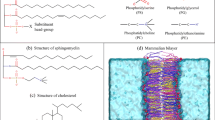Abstract
The dependences of adsorbed water state (obtained from the variations in 1H NMR spectra with the angle between the bilayer normal and magnetic field direction) and water diffusion along the bilayer normal (measured using pulsed field gradient 1H NMR) on hydration degree have been studied in macroscopically oriented bilayers of dioleoylphosphatidylcholine. The angle dependences of the shape of NMR spectrum are qualitatively different only for water concentrations higher and lower than that achieved by hydration from saturated vapors (χeq, about 23%). At concentrations lower than χeq, all water in the sample either makes the hydration shells of the lipid polar heads or is in fast exchange with the shell water, so the spin-echo signal from water is detected only within a narrow range of angles close to the magic angle, 54.7°. At concentration exceeding χeq, the spin-echo signal from water is retained at all orientations, suggesting that a portion of water between bilayers (quasi-free water) slowly exchanges with water bound to the polar heads. There is an inverse dependence of the coefficient of water self-diffusion through the bilayer system on the hydration degree, which is described in the Tanner model with account of water self-diffusion in the hydrophobic part of the bilayer. Bilayer permeability, distribution coefficient of molecules between aqueous and lipid phases, and water self-diffusion coefficient in the hydrophobic region of the bilayer are estimated.
Similar content being viewed by others
Abbreviations
- LC:
-
liquid-crystalline
- PFG:
-
pulsed field gradient
- DOPC:
-
1,2-dioleoyl-sn-glycero-3-phosphocholine
References
R. Koynova and M. Caffrey, Biochim. Biophys. Acta 1376, 91 (1998).
A. S. Ulrich and A. Watts, Biophys. J. 66, 1441 (1994).
K. Hristova and S. H. White, Biophys. J. 74, 2419 (1998).
A. Filippov, G. Oradd, and G. Lindblom, Langmuir 19, 6397 (2003).
R. J. Mashl, H. L. Scott, S. Subramaniam, and E. Jacobsson, Biophys. J. 81(6), 3005 (2001).
C. Faure, L. Bonakdar, and E. J. Dufourc, FEBS Lett. 405, 263 (1997).
Z. Zhou, B. G. Sayer, D. W. Hughes., et al., Biophys. J. 76, 387 (1999).
F. Volke, S. Eisenblatter, J. Galle, and G. Klose, Chem. Phys. Lipids 70(2), 121 (1994).
H. Bursing, S. Kundu, and P. Vohringer, J. Chem. Phys. 107, 2404 (2003).
A. Filippov, G. Oradd, and G. Lindblom, Biophys. J. 86, 891 (2004).
S. R. Wassall, Biophys. J. 71(5), 2724 (1996).
P. Wasterby, G. Oradd, and G. Lindblom, J. Magn. Res. 157, 156 (2002).
S. Paula, A. G. Volkov, A. N. Van Hoek, et al., Biophys. J. 70, 339 (1996).
J. Milhaud, Biochim. Biophys. Acta 1663, 19 (2004).
D. Bemporad, C. Luttmann, and J. W. Essex, Biophys. J. 87, 1 (2004).
T. H. Haines, FEBS Lett. 346, 115 (1994).
M. Jansen and A. Blume, Biophys. J. 68, 997 (1995).
P. Jedlovszky and M. Mezei, J. Phys. Chem. B. 105, 3614 (2001).
H. Leontiadou, A. E. Mark, and S. J. Marrink, Biophys. Chem. 86, 2156 (2004).
A. Finkelstein, Water movement through lipid bilayers, pores and plasma membranes. Theory and Reality Distinguished. Lecture Series of the Society of General Physiologists (John Willey, 1988), Vol. 4, pp. 1–228.
T. F. Weiss, Transport (The MIT Press, Cambridge, 1995).
M. A. Rudakova and A. V. Filippov, App. Magn. Res. 29, 451 (2005).
M. A. Rudakova, A. V. Filippov, and R. S. Gimatdinov, Biofizika 50, 878 (2005).
G. Oradd and G. Lindblom, in NMR of orientationally ordered liquids, Ed. by E. Burnell (Kluwer Academic Pubnshers, Dordrecht, 2003), pp. 399–418.
A. Filippov, G. Oradd, and G. Lindblom, Biophys. J. 84(5), 3079 (2003).
P. N. Sen, Concepts of Magnetic Resonance 23A(1), 1 (2004).
A. V. Filippov, M. A. Rudakova, G. Oradd, and G. Lindblom, Biofizika 52, (2007).
A. Carruthers and D. L. Melchior, Biochemistry 22, 5797 (1983).
J. E. Tanner, J. Chem. Phys. 69, 1748 (1978).
S. Tristram-Nagle and J. F. Nagle, Chem. Phys. of Lipids 127, 3 (2004).
M. Appel, G. Fleischer, D. Geschke, et al., Pulsedfield-gradient NMR analogue of the single-slit diffraction pattern.
W. S. Price, Pulsed-field gradient nuclear magnetic resonance as a tool for studying translational diffusion: Part 1, Concepts of Magnetic Resonance 9, 299 (1997).
D. Bemporad and J. W. Essex, J. Phys. Chem. 108, 4875 (2004).
Author information
Authors and Affiliations
Additional information
Original Russian Text © A.M. Khakimov, M.A. Rudakova, A.V. Filippov, 2007, published in Biofizika, 2007, Vol. 52, No. 5, pp. 840–849.
Rights and permissions
About this article
Cite this article
Khakimov, A.M., Rudakova, M.A. & Filippov, A.V. Water state and diffusion through lipid bilayers: Effect of hydration degree. BIOPHYSICS 52, 453–461 (2007). https://doi.org/10.1134/S0006350907050016
Received:
Accepted:
Issue Date:
DOI: https://doi.org/10.1134/S0006350907050016




